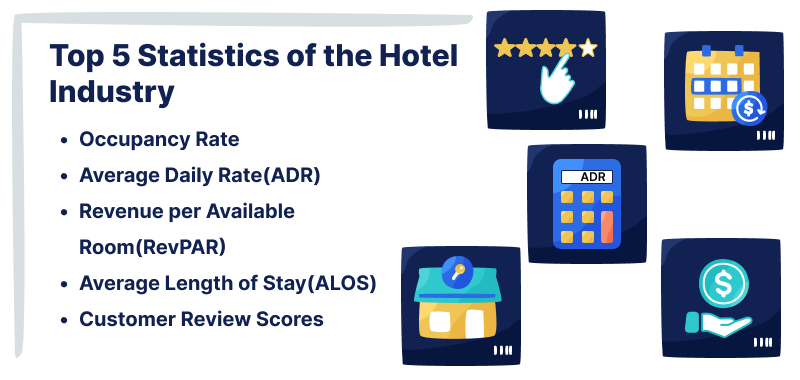The hotel industry is one of the many fast growing industries.
It is getting difficult to sustain and succeed in this competitive industry day by day.
Therefore, regular monitoring and analysis of hotel statistics are necessary. It helps hoteliers draw meaningful conclusions and take needed actions. In addition, it also helps them stay ahead of their competitors.
Various statistics are available in the market to analyze the hotel’s performance.
Therefore, Finding out which works best is a challenging task. Let me help you with this task through this article.
Let’s discuss the top 5 statistics of the hotel that best analyzes the hotel’s growth.
What do you mean by Statistics of the Hotel Industry?
Statistics refers to the data and metrics that provide valuable insights.
The data regarding the hotel’s performance, operations, and market positions are called Statistics of the Hotel.
A few of them include occupancy rate, average daily rate, average length of stay, customer satisfaction score, etc.
Why Track Statistics of The Hotel Industry?
Hoteliers can optimize operations by regularly tracking the statistics of the hotel.
Through this, they can also enhance their guest experiences. It helps hoteliers analyze their current market position.
To help them stay competitive in the hotel industry.
Hotels regularly track and monitor the stats of their hotels. It helps them assess their hotel performance.
In addition, it also helps them monitor the speed at which they are chasing their set targets.

Top 5 Vital Statistics of the Hotel Industry
Here are the top 5 statistics of the hotel industry for best analyses:
Occupancy Rate
Occupancy rate refers to the percentage of occupied rooms from all available hotel rooms over a specific period. It demonstrates the booking rate of the hotel.
A hotelier can analyze the effectiveness of his current strategies by analyzing the occupancy rate. A high occupancy rate indicates successful strategies.
Through occupancy rates, hoteliers draw insights into hotel bookings and revenue.
Conclusions drawn from these statistics will help hoteliers optimize hotel occupancy in low seasons.
How to find the Occupancy Rate?
To find the occupancy rate, divide the number of occupied or booked rooms by the total number of rooms. Then multiply the result by 100 to find the percentage.
Occupancy Rate = (Number of Rooms Occupied / Total Number of Available Rooms) x 100
Average Daily Rate (ADR)
ADR represents the daily average selling price of the hotel rooms. Monitoring ADR helps to create effective pricing strategies.
Therefore, effective pricing strategies help in generating hotel profits. Furthermore, it also helps in building the hotel’s brand image.
The Formula for Calculating Average Daily Rate
To find the Average daily rate, divide the total revenue earned by all booked rooms by the total number of sold rooms.
Average daily rate = Total Revenue earned through hotel rooms / Total Number of Sold Rooms.
Revenue per Available Room (RevPAR)
RevPAR is a metric that measures the success of any hotel.
It depends on two metrics:
- Occupancy Rate
- Average Daily Rate
It measures the hotel’s ability to maximize revenue based on available rooms.
A higher RevPAR indicates effective pricing strategies.
The formula for calculating RevPAR
RevPAR = ADR x Occupancy Rate
Average Length of Stay (ALOS)
The average length of stay refers to the average number of nights guests stay at the hotel.
From the average length of stay, hotels can interpret the average duration of their guest stay.
It will help them analyze what necessary changes they can make to improve the guest experience.
A higher average length of stay indicates satisfied customers.
The Formula for ALOS
To calculate the average length of stay, divide the total number of nights for which the total number of booked rooms books the rooms.
ALOS = Total Number of Room Nights Sold / Total Number of Bookings
Customer Review Scores
In today’s time, online reviews significantly influence a hotel’s business. Therefore, hotels should regularly monitor guest feedback and review scores.
Guests post their reviews on various platforms, such as TripAdvisor or Booking.com. Hotels should monitor these reviews. It helps hotels identify areas for improvement.
Moreover, it helps hotels maintain a positive brand image.
Keeping track of customer review scores will help hoteliers enhance guest experiences and increase revenue.
Conclusion
Hoteliers should regularly monitor the statistics to analyze the growth of the hotel business.
There are various statistics of the hotel that a hotelier can analyze to evaluate his hotel management and marketing strategies.
Here we have shared with you the top 5 statistics that every hotelier can use to predict his hotel’s current state.
Evaluation of these statistics will help hotels stay informed about the progress speed of the hotel.
Moreover, it will also help them take necessary actions in their strategy.
Therefore, we can conclude that a hotelier should carefully track the above discussed statistics and extract valuable insights from them. Inferring these statistics can help them make their hotel successful in no time.
Get In Touch
I hope you have understood the various statistics explained above. Every statistic plays a vital role in the hotel industry. Each can derive meaningful conclusions about the hotel’s performance.
Hoteliers can draw meaningful conclusions from these statistics.
They can ease the hotel analysis process by using PMS with an inbuild insightful dashboard. One such Free Property Management System is QloApps.
QloApps displays various hotel statistics through graphs and charts on the dashboard. So try QloApps and ease your hotel management and growth analysis process.

Be the first to comment.